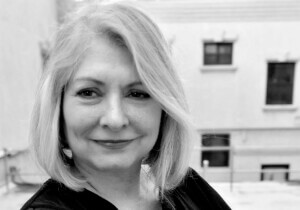At the end of 2022, Cathleen McGuigan stepped down from the role of editor in chief of Architectural Record, a post she had held since 2011. Josephine Minutillo, who has been with the publication since 2001, has now taken over the job. To celebrate this changing of the guard at the U.S.’s oldest continuously publishing architecture magazine, AN’s Editor in Chief Aaron Seward spoke with McGuigan to discuss her career, the state of architecture, and her plans for the future. Their conversation has been edited for length and clarity.
Aaron Seward: Some of our readers might not know you or your background, so could you give us a brief history of how you got into design journalism?
Cathleen McGuigan: After college, I began freelancing for newspapers and little magazines. Then I came to New York and worked at Newsweek, which was great training in journalism. I started as a researcher for the art critic and the architecture critic. I liked interviewing architects because they were good talkers—they have to know how to sell their projects to clients, and in that way aren’t like artists, who often can be at a loss for words. And though I continued to write about various aspects of culture, I kind of revived the architecture beat at the magazine, long after the old critic had left.
I spent a year at the Harvard Graduate School of Design (GSD) as a Loeb Fellow and learned so much more about the field—before that, I used to say that I was practicing architectural journalism without a license. At the GSD, I could indulge in my longtime interest in the evolution of cities and in urban design. I wrote a series of big stories on cities for Newsweek, such as Barcelona preparing for the ‘92 Olympics, and the transition of Berlin from a divided city to the new capital of a united Germany, exploring not only new architecture but how the politics and history of Germany would be reflected in the renewed city. And then for seven years I was also the arts editor, running all the cultural coverage.
I knew Architectural Record, of course— and felt very honored to be offered the editor in chief job in 2011. I was able to bring experience both as a journalist covering the field and as an editor, managing a staff.
AS: It’s interesting that you started at Newsweek, which is obviously a general-interest publication with a broad readership, and then moved to Record, which is a specialized publication with mainly an audience of architects. Did that affect the way you approached journalism? Or do you feel like there was a continuum in terms of the way you cover the subject?
CM: Both. We absolutely have a primary audience of architects, and what we write is at a more sophisticated and professional level than what I did at Newsweek, where, as you say, I was explaining architecture and urbanism to a more general audience. At Record we focus, of course, on what matters to architects, such as structure and materials. That was a learning curve for me. The first piece I wrote for Record was on the Rothschild Bank in London designed by Ellen van Loon of OMA. I was going to be edited by Suzanne Stephens; she is a great editor, and though I was technically her boss, I was terrified I was going to say something stupid or get something wrong. I really worked on reporting the details of the structure and the construction, which was interesting because the building is inserted into an almost impossibly tight site behind a beautiful little Christopher Wren church. It was fun to write about, but challenging because we have such high standards for getting everything right.
I brought wider journalistic interests to Record too. I was thinking about identifying trends in the field and also about the larger context of architecture and the question of how we could bring the social and political aspects that surround building to our readers.
AS: Where did you find the architecture profession when you started editing Record? How have you seen the profession change over these years?
CM: In the last decade, we’ve been living through an interesting period in architecture where concerns about urbanism, social issues, and sustainability have grown dramatically. When I was writing about architecture for Newsweek in the late 1980s, critics were mostly writing about buildings as objects, and architects were designing buildings as objects. And though they still are—and that’s fine—our values have changed. Not just in terms of energy savings but also considering the embodied carbon of materials, how design and construction affect the climate crisis, and how architects can have a positive impact. Equity of the public realm and the idea that design is for everybody is something that the whole profession has become more conscious of. We have extensively covered women in architecture, and though I think we’ve not seen enough change, there is still quite significant progress for women advancing in firms and in closing the pay gap, especially after the #MeToo movement erupted. And after the murder of George Floyd in 2020, we had a whole new movement looking at how poorly architecture often serves communities of color and how little representation people of color have in the profession.
AS: From our point of view at AN, there’s also a desire to have more representation from different voices in architectural journalism and criticism. Do you see that that’s changed much at Record?
CM: I feel that the young journalists really help refresh our vantage point. One of our young reporters actively covered the architecture unionization movement, and she and one of her peers are especially sensitive to issues of gender and race. This is what’s so great about having a robust website. On the one hand, we’re putting out a monthly magazine that’s very carefully considered, and at the same time we’re essentially running a daily newspaper online, and this gives us the ability to cover a wide spectrum of issues, news, and terrific architectural projects.
AS: You came from a world of strictly print, and now we’re in this hybrid world where print is still relevant but digital has taken a huge part of the market share. How do you see these two platforms functioning together today?
CM: They function together, but the biggest challenge is how to better knit them together. Our print issue is still the anchor of what we do. Our owners and our publisher want that. But we have many, many more eyeballs online globally, and that’s very exciting. One of the challenges is when you do certain classic magazine features that might have several pieces to them, how do you present all that content in a digital format so that relevant stories are linked together but it’s not a 5,000-word read? That’s one thing that we’ve been working on and is sure to be a priority going forward for the next editor, Josephine Minutillo—who is great, by the way.
AS: This sounds like what we discuss at AN. Speaking of which, in our chat earlier you spoke of Record and AN as “friendly competitors.” Obviously, Record is over 130 years old and AN is just turning 20, but what is your perspective on our publication?
CM: The Architect’s Newspaper became essential reading from the moment it appeared because it is a newspaper, with a wide range of coverage about firms, practice, trends, as well as projects—and gossip, let’s not forget about gossip! I really liked and admired your cofounder Bill Menking for all that he did.
AS: What are your plans now after stepping down as Record’s editor in chief?
CM: I’m going to continue as a consulting editor, and I will continue to run Record’s Women in Architecture Forum & Awards, which we started nine years ago. I’m very proud of the fact that we honored Carol Ross Barney as Design Leader last October and two months later AIA gave her the Gold Medal; I feel like we’ve been ahead of the curve. We give five awards annually, so at this point it’s a fascinating group of 45 terrific architects doing a variety of really interesting work.
I also have my own independent writing projects. And I want to continue to be an advocate for some of the areas that we focused on at Record, especially affordable housing, which we all know is at a crisis point. There are solutions in other parts of the world that we find very difficult to bring to the U.S. Obviously, it’s not just a matter of architecture, it’s also a matter of policy and economics, but thoughtful design can have a powerful role.
AS: Could you speak a little bit about the value of having a global perspective when you’re covering architecture?
CM: It’s absolutely essential. It can be really inspiring, if you are trying to design affordable housing in the U.S., for example, to see some of the projects that come from France, Finland, or the Netherlands, where architects manage to create beautiful, humane housing that’s not super expensive. We’ve seen some fantastic architecture come out of China recently. We’ve seen interesting projects come out of Latin America. And we’re turning our gaze toward Africa, which is so exciting, because it’s a part of the world most of us know so little about. The upcoming Venice Architecture Biennale, curated by Lesley Lokko, founder of the African Futures Institute, will be especially interesting, I think. It’s very positive for architects— young architects in particular—to see a whole range of buildings and a variety of viewpoints. And that is the most exciting thing about covering architecture today.
AS: That loops back to our earlier discussion about considering urban and social contexts when we review individual projects. It’s certainly what makes this world of architectural journalism exciting to me: the idea that architecture is something that touches us all and we all have the authority to assess it, to judge it, and to find different things about it that delight us as well as make us upset. Long live architectural journalism.
CM: Carol Ross Barney said that she likes doing public projects not only because she’s an architect but because she’s also the client. She’s part of the public. She’s a citizen. I think that we journalists reflect that audience too—the audience that is in architecture and that is for architecture.











